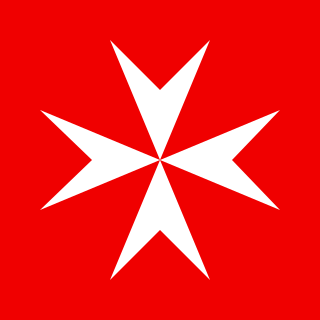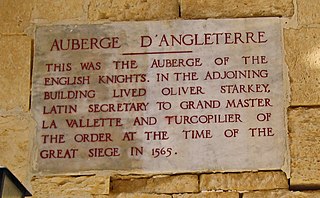
The Sovereign Military Order of Malta (SMOM), officially the Sovereign Military Hospitaller Order of Saint John of Jerusalem, of Rhodes and of Malta, commonly known as the Order of Malta or Knights of Malta, is a Catholic lay religious order, traditionally of a military, chivalric, and noble nature. Though it possesses no territory, the order is often considered a sovereign entity of international law.

Sir Thomas Docwra was Grand Prior of the Order of Knights of the Hospital of Saint John of Jerusalem in England, and thus ranked as Premier Lay Baron of England.
The Russian tradition of the Knights Hospitaller is a collection of charitable organisations claiming continuity with the Russian Orthodox grand priory of the Order of Saint John. The order emerged when Malta was captured by Napoleon in 1798 during the expedition to Egypt. The Grand Master at the stronghold of Malta, Ferdinand von Hompesch, failed to anticipate or prepare for the threat. The Order continued to exist in a diminished form and negotiated with European governments for a return to power. The Emperor of Russia gave shelter to the largest number of Knights in St Petersburg and this gave rise to the Russian tradition of the Knights Hospitaller and recognition within the Russian Imperial Orders. In gratitude the Knights declared Ferdinand von Hompesch deposed and Emperor Paul I was elected as the new Grand Master. The continuous Order was also approved by the Papacy, but due to British fear of Russian taking presence in the Mediterranean and because many knights were Orthodox the Order became de facto the traditional Order but de jure not recognised similar or at par with the formation of the 19th-century Sovereign Military Order of Malta.

The Order of St John, short for Most Venerable Order of the Hospital of Saint John of Jerusalem and also known as St John International, is a British royal order of chivalry constituted in 1888 by royal charter from Queen Victoria and dedicated to St John the Baptist.
Sir Thomas Tresham was a leading Catholic politician during the middle of the Tudor dynasty in England.

The Bailiwick of Brandenburg of the Chivalric Order of Saint John of the Hospital at Jerusalem, commonly known as the Order of Saint John or the Johanniter Order, is the German Protestant branch of the Knights Hospitaller, the oldest surviving chivalric order, which generally is considered to have been founded in Jerusalem in 1099.
The Knights of Justice or Professed Knights, form the first of the three classes of members of the Sovereign Military Order of Malta together with the professed conventual chaplains. They make vows of poverty, chastity, and obedience. According to the group's Code, "they are religious in all respects and they comply with the universal and particular norms that concern them."

The Knights Templar, full name The United Religious, Military and Masonic Orders of the Temple and of St John of Jerusalem, Palestine, Rhodes and Malta, is a fraternal order affiliated with Freemasonry. Unlike the initial degrees conferred in a regular Masonic Lodge, which only require a belief in a Supreme Being regardless of religious affiliation, the Knights Templar is one of several additional Masonic Orders in which membership is open only to Freemasons who profess a belief in Christianity. One of the obligations entrants to the order are required to declare is to protect and defend the Christian faith. The word "United" in its full title indicates that more than one historical tradition and more than one actual order are jointly controlled within this system. The individual orders 'united' within this system are principally the Knights of the Temple, the Knights of Malta, the Knights of St Paul, and only within the York Rite, the Knights of the Red Cross.

There are Masonic degrees named after the Knights Templar but not all Knights Templar Orders are Masonic.

The Order of Knights of the Hospital of Saint John of Jerusalem, commonly known as the Knights Hospitaller, was a medieval and early modern Catholic military order. It was founded in the Kingdom of Jerusalem in the 12th century and was headquartered there until 1291, thereafter being based in Kolossi Castle in Cyprus (1302–1310), the island of Rhodes (1310–1522), Malta (1530–1798), and Saint Petersburg (1799–1801).

Richard Brooke or Broke bought the manor of Norton, near Runcorn, Cheshire from Henry VIII in 1545 following the dissolution of the monasteries. The manor included the former monastery of Norton Priory and also the settlements of Norton, Stockham, Acton Grange and Aston Grange in Cheshire and Cuerdley in Lancashire.

Sir Adrian Fortescue was a courtier at the court of King Henry VIII of England and member of the Third Order of Saint Dominic who was executed in 1539 and later beatified as a Roman Catholic martyr.

Clerkenwell Priory was a priory of the Monastic Order of the Knights Hospitallers of St John of Jerusalem, in present Clerkenwell, London. Run according to the Augustinian rule, it was the residence of the Hospitallers' Grand Prior in England, and was thus their English headquarters. Its great landholding – until Protestant monarch Edward VI of England – was in the ancient parish of Marylebone, in the now Inner London area known as St John's Wood, which it had farmed out on agricultural tenancies as a source of produce and income.

Sir Oliver Starkey (c.1523-83/86), was an English knight who lived in the 16th century. He was the only English knight present at the siege of Malta. It was wrongly assumed that he was buried in the crypt of St. John's Co-Cathedral in Valletta. The tombstone with his name on it contains only a poem written by Oliver Starkey for Grand Master Jean de La Valette. The Poem reads, in translation:'To God, Supreme, Almighty, Sacrosanct. He [La Valette] was the dread of Asia and Libya and once the guardian of Europe, after he had subdued the Turks by means of his Sacred Arms, the first one to lie buried in the grave, here in this propitious city of Valletta which he founded, worthy of eternal honour. Fra. Oliver Starkey, Pro-Turcopolier, wrote [this] poem.'
Richard Shelley (1513?–1589?) was a diplomat and the last Grand Prior of the Knights of Saint John in England.

The Military and Hospitaller Order of Saint Lazarus of Jerusalem is an ecumenical Christian self-styled order statuted in 1910 by a council of Catholics in Paris, France, initially under the protection of Patriarch Cyril VIII Jaha of the Melkite Greek Catholic Church. In the 1920s it expanded its jurisdiction enrolling members from other countries in Europe and in the Americas. It re-established the office of grand master in 1935 linking the office to members of the Spanish royal family. It assumed an ecumenical dimension in the 1950s to expand its membership to individuals of other Trinitarian Christian denominations in British Commonwealth countries.

Sir William Weston was the last Prior of the Order of Knights of the Hospital of Saint John of Jerusalem in England before the Dissolution of the Monasteries, during the reign of King Henry VIII. As such he ranked as Premier Baron in the roll of peers. He is characterised as one of the influential adherents of the papacy. His cadaver effigy survives in the crypt of the Priory Church of St John, Clerkenwell in Middlesex, the former headquarters of the Order.
Robert fitz Richard, also known as Roberto di Riccardi and Robert the Hospitaller, was a 12th–century Grand Prior of the Knights Hospitaller in England. He was the son of Richard fitz Eustace and Albreda de Lacy.

John Paveley was Grand Prior of the Order of Knights of the Hospital of Saint John of Jerusalem from 1358 until his death in 1371. In 1360 he served as Admiral of the Fleet against the French towards the end of the first phase of the Hundred Years' War.












